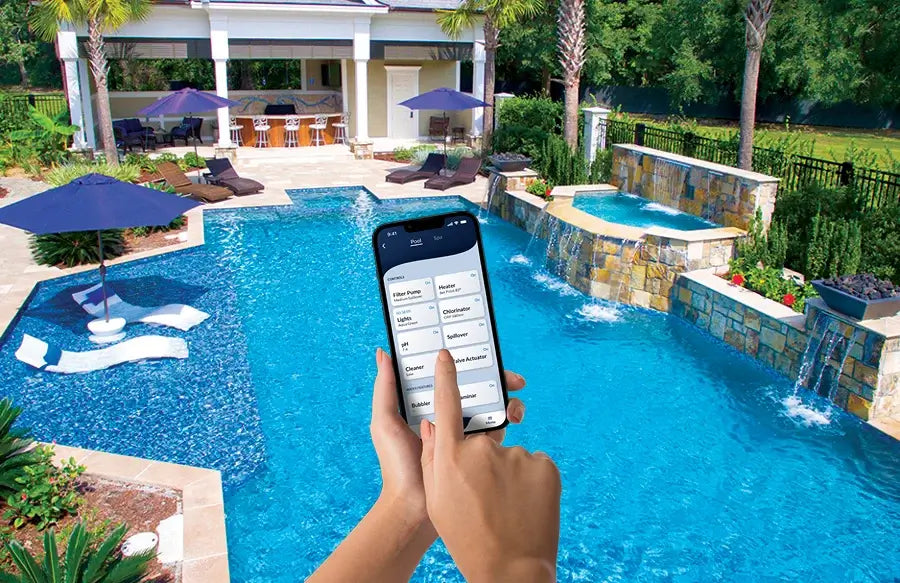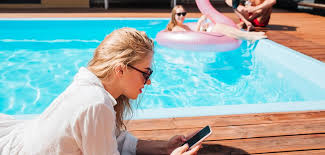In the age of smart homes and connected devices, the swimming pool—once a bastion of manual maintenance and constant attention—has joined the ranks of modern technology. Today's pool owners can monitor, adjust, and control virtually every aspect of their aquatic retreat with nothing more than the smartphone in their pocket.
This revolution in pool management has transformed ownership from a time-consuming responsibility into a seamless part of digital life. Let's dive into the world of smartphone pool control, exploring the latest apps, features, and innovations that are making waves in 2025.
The Evolution of Pool Control
Not long ago, managing a pool meant manually adjusting valves, flipping switches at a control panel, and physically testing water chemistry. Today's smart pool controllers have fundamentally changed this paradigm by centralizing operations and making them accessible via intuitive smartphone applications.
The transformation began with basic timer control apps but has rapidly evolved to include comprehensive management systems that integrate with broader smart home ecosystems. Modern pool owners can now enjoy unprecedented convenience and efficiency through their mobile devices.
Leading Pool Control Apps in 2025
The market is dominated by several key players, each with distinct features and compatibility considerations. Here's a rundown of the major contenders:
Pentair Home App (for Pentair Systems)
The Pentair Home app works with Pentair's IntelliCenter, EasyTouch, and IntelliConnect systems to provide comprehensive control over pool operations.
Key Features:
- Intuitive dashboard interface with at-a-glance status indicators
- Remote temperature control and scheduling
- Chemical monitoring (when paired with IntelliChem)
- Equipment health monitoring and maintenance alerts
- Energy usage tracking and optimization suggestions
- Voice control integration with major smart home platforms
Pentair's app stands out for its robust energy management tools, which can help users optimize pump schedules based on electricity rates and usage patterns.
Hayward OmniLogic App (for Hayward Systems)
Hayward's app works with their OmniLogic and OmniHub controllers to provide streamlined control of pool functions.
Key Features:
- Customizable themes and interface layouts
- Advanced scheduling options with calendar view
- Chemical automation monitoring
- Multiple user accounts with individualized permissions
- Extensive voice assistant integration capabilities
- Backyard scene creation for coordinated control of multiple features
Hayward's implementation is particularly strong in the smart home integration department, with what many consider the most seamless connection to platforms like Amazon Alexa and Google Home.
iAquaLink (for Jandy/Zodiac Systems)
The iAquaLink app works with Jandy AquaLink systems as well as their standalone iQPUMP01 controller.
Key Features:
- One-touch favorite settings access
- Comprehensive scheduling capabilities
- Water feature and lighting controls
- Freeze protection monitoring
- Intuitive pump speed adjustment for variable-speed pumps
- Real-time temperature monitoring
The iAquaLink app is frequently praised for its user-friendly interface and reliable connection, making it accessible even for non-tech-savvy pool owners.
Independent Options
Beyond the major manufacturers, several independent options have emerged for pools with mixed equipment or for owners seeking specific features:
- Pool Sense: Focuses primarily on water chemistry monitoring
- Sutro: Provides detailed water analysis and chemical recommendations
- WaterGuru: Specialized in chemical management and water quality
These independent apps often work alongside the main control apps to provide enhanced functionality in specific areas.
Essential Smartphone Control Features
Regardless of which system you choose, several key features define the modern pool control experience:
Remote Equipment Control
The fundamental capability of any pool control app is the ability to operate equipment from anywhere:
- Pump Control: Adjust speeds, set schedules, and monitor performance
- Heater Management: Set temperature, create heating schedules, and receive energy usage reports
- Lighting Control: Change colors, create light shows, and set ambiance
- Water Feature Operation: Activate fountains, waterfalls, and other features
This remote accessibility means you can prepare your pool for use before arriving home or make adjustments without leaving your lounge chair.
Water Chemistry Monitoring
Modern systems leverage sensors to continuously monitor water chemistry and relay the information to your smartphone:
- pH Monitoring: Track acidity levels to ensure proper balance
- Sanitizer Levels: Monitor chlorine or other sanitizer concentrations
- Salt Systems: Monitor salt levels and cell performance for saltwater pools
- Temperature: Track water temperature for comfort and safety
The best systems don't just report data but also provide actionable recommendations based on the readings.
Energy Management
As utility costs rise, energy management has become a crucial feature:
- Variable Speed Control: Fine-tune pump speeds to optimize energy usage
- Time-of-Use Scheduling: Run equipment during off-peak electricity hours
- Efficiency Reporting: Track energy consumption and identify savings opportunities
- Solar Integration: Coordinate with solar heating systems for optimal energy use
These features can reduce operating costs significantly, with some users reporting up to 70% savings on pool-related energy expenses.
Smart Home Integration
The ability to incorporate pool control into broader smart home ecosystems adds another dimension of convenience:
- Voice Control: Manage your pool using voice assistants like Amazon Alexa or Google Assistant
- Scene Integration: Include pool features in whole-home scenes (e.g., "Entertainment Mode")
- Geofencing: Trigger pool actions based on your location
- IFTTT Support: Create conditional actions based on various triggers
For example, you might create a voice command like "Alexa, prepare the pool for swimming" that adjusts the temperature, turns on the pump, and activates specific lighting—all from a simple phrase.
AI and Advanced Features in 2025
The pool control landscape in 2025 has been transformed by artificial intelligence and advanced analytics. Here are some cutting-edge features now available:
Predictive Maintenance
Advanced algorithms now analyze equipment performance to predict potential issues before they occur:
- Pump Performance Analysis: Detection of efficiency decline or potential failure
- Heater Diagnostics: Monitoring of ignition cycles and performance metrics
- Filter Pressure Tracking: Automated backwash recommendations based on actual need
- Component Lifespan Estimation: Predictions of when parts may need replacement
These predictive capabilities can prevent costly emergency repairs and extend equipment life.
Weather-Responsive Automation
Today's systems use weather forecasts and current conditions to make intelligent adjustments:
- Rain Prediction: Adjusting chemical dosing before rainfall
- Temperature Adaptation: Modifying heating schedules based on ambient temperature forecasts
- Wind Compensation: Adjusting water features during high wind conditions
- UV Index Response: Enhanced sanitization during periods of intense sunlight
By responding to weather conditions, these systems maintain optimal pool conditions while minimizing resource usage.
Water Conservation Tools
As water becomes an increasingly precious resource, conservation features have gained prominence:
- Evaporation Monitoring: Tracking water loss and providing cover recommendations
- Leak Detection: Identifying potential water loss beyond normal evaporation
- Optimized Backwashing: Minimizing water usage during filter cleaning
- Smart Water Level Control: Precision refilling that prevents overfilling
According to the EPA's WaterSense program, smart pool management can reduce water waste by thousands of gallons annually.
Enhanced User Experience
The user interface and experience have evolved substantially:
- Personalized Dashboards: Customizable layouts showing the information most relevant to you
- Usage Pattern Learning: Systems that adapt to your preferences over time
- Augmented Reality Features: Some apps now offer AR views for visualizing equipment status
- Maintenance Walkthroughs: Step-by-step guided maintenance procedures
These enhancements make pool management more accessible and intuitive, even for novice pool owners.
Setting Up Your Smartphone Pool Control
If you're looking to implement smartphone control for your pool, here's a simplified roadmap:
1. Assess Your Current Equipment
Start by evaluating your existing pool equipment for compatibility:
- Controller Compatibility: Determine if your current equipment works with smart controllers
- Equipment Age: Older equipment may require replacement or adapters
- Network Access: Ensure your pool equipment area has reliable Wi-Fi coverage
For more details on compatibility, check our Smart Pool Controller Compatibility Guide.
2. Choose Your System
Select a control system based on your needs and existing equipment:
- Complete Systems: Full controller replacements with comprehensive features
- Add-On Modules: Devices that connect to existing equipment
- Standalone Sensors: Independent devices that monitor specific aspects
The right choice depends on your budget, desired features, and current setup.
3. Installation Considerations
While many systems advertise DIY installation, there are important factors to consider:
- Electrical Work: Most controllers require connection to your pool's electrical system
- Safety Requirements: Ensure all work meets local electrical codes
- Professional Installation: Consider professional setup for complex systems
For safety and warranty reasons, professional installation is often recommended.
4. App Setup and Configuration
Once installed, you'll need to set up and optimize the smartphone app:
- Network Connection: Connect the controller to your home Wi-Fi
- Account Creation: Set up any required accounts
- Equipment Configuration: Configure each piece of connected equipment
- Customization: Personalize schedules, scenes, and alerts
This initial setup phase is crucial for maximizing the system's effectiveness.
Comparing Costs: Is Smart Control Worth It?
The investment in smartphone control varies widely based on your chosen system and existing equipment:
Typical Costs
- Entry-Level Systems: Basic control modules start around $500-$700
- Mid-Range Systems: More comprehensive controllers range from $1,000-$2,000
- Premium Systems: Full-featured systems with extensive integration can exceed $3,000
- Annual Subscription Fees: Some platforms charge ongoing fees for advanced features
Return on Investment
Despite the upfront cost, many pool owners find the return on investment compelling:
- Energy Savings: Reduced electricity usage through optimized scheduling
- Chemical Savings: Precise dosing reduces chemical waste
- Water Conservation: Smart systems minimize water loss and waste
- Equipment Longevity: Preventative maintenance extends component life
- Time Savings: Dramatically reduced hands-on maintenance time
Privacy and Security Considerations
As with any connected technology, security deserves attention:
- Data Privacy: Understand what pool usage data is collected and how it's used
- Network Security: Ensure your home network is secure to protect connected devices
- Access Control: Utilize strong passwords and multi-factor authentication
- Guest Access: Consider temporary access options for service providers or guests
Taking basic security precautions will protect both your pool system and your broader home network.
Future Trends in Pool Control
Looking beyond 2025, several emerging trends are shaping the future of pool management:
Expanded AI Integration
Artificial intelligence will continue to transform pool management:
- Enhanced Predictive Capabilities: More accurate maintenance forecasting
- Water Chemistry Optimization: AI-driven chemical balance management
- Energy Optimization: Increasingly sophisticated energy usage algorithms
- Pattern Recognition: Systems that learn and adapt to usage patterns
These AI advancements will make pool management increasingly autonomous.
Immersive Control Experiences
The user interface will continue to evolve:
- Voice Control Dominance: Enhanced natural language processing
- Gesture Control: Motion-based pool management
- Mixed Reality Integration: AR and VR views of pool systems and status
- Simplified Visualization: Increasingly intuitive graphical interfaces
These developments will make pool control more natural and seamless.
Enhanced Integration
Pool systems will become more deeply integrated with other technologies:
- Whole-Home Water Management: Integrated control of all water systems
- Energy Grid Integration: Dynamic response to utility grid conditions
- Irrigation Coordination: Shared water and schedule management with landscape systems
- Health and Wellness Integration: Connection with fitness and health platforms
This integration will position the pool as an integral part of the smart home ecosystem.
Conclusion
The smartphone transformation of pool management represents one of the most significant advancements in pool ownership. From basic remote control to sophisticated AI-driven management, these technologies have fundamentally changed what it means to own and maintain a swimming pool.
As we move forward, the line between manual and automated pool care continues to blur, with smartphone apps taking on an increasingly central role. For today's pool owners, embracing these technologies means not just keeping up with trends, but genuinely enhancing their pool ownership experience through convenience, efficiency, and peace of mind.
Whether you're considering your first smart controller or looking to upgrade an existing system, the smartphone revolution in pool management offers compelling benefits that make the investment worthwhile for most pool owners.




Leave a comment
This site is protected by hCaptcha and the hCaptcha Privacy Policy and Terms of Service apply.